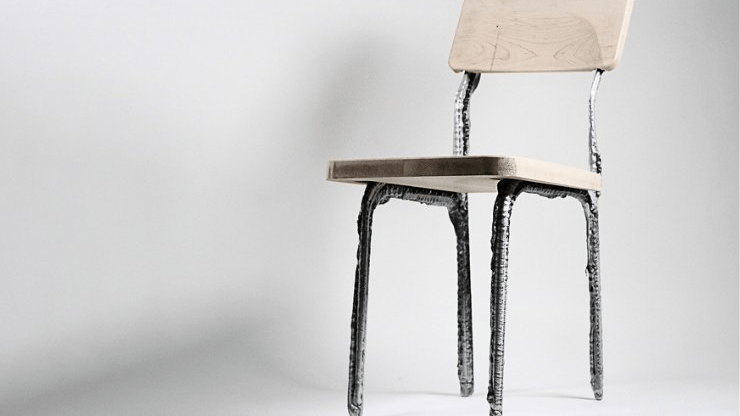The secret to cranking out a furniture-sized metal frame in minutes is Liquid Metal Printing (LMP), demonstrated by researchers at the Massachusetts Institute of Technology. They’ve demonstrated printing aluminum frames for tables and chairs, which are perfectly solid and able to withstand post-processing like drilling and milling.
The system heats aluminum in a graphite crucible, and the molten metal is gravity-fed through a ceramic nozzle and deposited into a bed of tiny 100-micron glass beads. The beads act as both print bed and support structure, allowing the metal to cool quickly without really affecting the surface. Molten aluminum is a harsh material to work with, so both the ceramic nozzle material and the glass beads to fill the print bed were selected after a lot of testing.
This printing method is fast and scalable, but sacrifices resolution. Ideally, the team would love to make a system capable of melting down recycled aluminum to print parts with. That would really be something new and interesting when it comes to manufacturing.
The look of the printed metal honestly reminds us a little of CandyFab from [Windell Oskay] and [Lenore Edman] at Evil Mad Scientist, which was a 3D printer before hobbyist 3D printers or kits were really a thing. CandyFab worked differently — it used hot air to melt sugar together one layer at a time — but the end result has a similar sort of look to it. Might not be pretty, but hey, looks aren’t everything.
(Update: see it in action in this video, which is also embedded just below. Thanks [CityZen] for sharing in the comments!)

















CandyFab sounds like a sweet idea.
It’s not clear if they’re pushing the nozzle through a bulk powder, or if they’re spreading the glass as a layer as they work upwards.
Very cool technique! I bet you could get really, really tough parts by using rough sand rather than spheres, and that would also bring the price down.
Video here makes it clear: (it’s the former)
https://news.mit.edu/2024/researchers-demonstrate-rapid-3d-printing-liquid-metal-0125
Thank you. This answers my “this has to warp terribly”.
Somebody called techartisan posted this in another article. The patents bit seems germane here as well:
“Beyond a huge number of photopolymers that are room temperature solid but jettable at an elevated temperature the most useful substance to jet of all….WAX. From solvent dissolvable, to water soluble, to more durable waxes similar to those used in dental and jewelry modelling. The main limit to what can be done are patents held by 3dsystem blocking the xerox multijet head and ones owned by stratasys through their acquisition of solidscape IP. While FDM is nearly open and free, and photopolymer resin printers patents expiring or sidesteppable….Jet modelling is still largely locked away from the law abiding…..unless you can afford to pay“
Blast from the past. That was the case when I posted that.
The main patent behind 3dsystems multijet systems 684116B2 expired in October 2022.
There have been a few industrial printers that have taken advantage of that already, while a couple are cheaper than 3dS they are still running low to mid5 figures, so really not hobbyist gear.
3dsystems has continued to modify and drop new patents around the tech, as have a few others. MIT’s recent Vision Controlled Jetting adds 3d scanning, removing the planarization step by dynamically adjusting deposition paths instead.
The system in this HAD article isnt using jetting, so sorry for spinning off topic but I think ISeeISee was highlighting that MIT means this is patent blocked for the next couple of decades as well.
The whole industry is a patent minefield and the big boys are well funded and quick to litigate so tread cautiously.
I love it:
-drop new patents
-patent blocking
-whole industry is a patent minefield
-angry big boys
Thankyou for sharing your insight.
Please keep up the good work.
>Just toss your failed prints back into the top of the machine and print them again
I am officially jealous